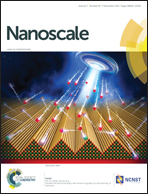Mesoporous bioactive glass nanolayer-functionalized 3D-printed scaffolds for accelerating osteogenesis and angiogenesis
Abstract
The hierarchical microstructure, surface and interface of biomaterials are important factors influencing their bioactivity. Porous bioceramic scaffolds have been widely used for bone tissue engineering by optimizing their chemical composition and large-pore structure. However, the surface and interface of struts in bioceramic scaffolds are often ignored. The aim of this study is to incorporate hierarchical pores and bioactive components into the bioceramic scaffolds by constructing nanopores and bioactive elements on the struts of scaffolds and further improve their bone-forming activity. Mesoporous bioactive glass (MBG) modified β-tricalcium phosphate (MBG-β-TCP) scaffolds with a hierarchical pore structure and a functional strut surface (∼100 nm of MBG nanolayer) were successfully prepared via 3D printing and spin coating. The compressive strength and apatite-mineralization ability of MBG-β-TCP scaffolds were significantly enhanced as compared to β-TCP scaffolds without the MBG nanolayer. The attachment, viability, alkaline phosphatase (ALP) activity, osteogenic gene expression (Runx2, BMP2, OPN and Col I) and protein expression (OPN, Col I, VEGF, HIF-1α) of rabbit bone marrow stromal cells (rBMSCs) as well as the attachment, viability and angiogenic gene expression (VEGF and HIF-1α) of human umbilical vein endothelial cells (HUVECs) in MBG-β-TCP scaffolds were significantly upregulated compared with conventional bioactive glass (BG)-modified β-TCP (BG-β-TCP) and pure β-TCP scaffolds. Furthermore, MBG-β-TCP scaffolds significantly enhanced the formation of new bone in vivo as compared to BG-β-TCP and β-TCP scaffolds. The results suggest that application of the MBG nanolayer to modify 3D-printed bioceramic scaffolds offers a new strategy to construct hierarchically porous scaffolds with significantly improved physicochemical and biological properties, such as mechanical properties, osteogenesis, angiogenesis and protein expression for bone tissue engineering applications, in which the incorporation of nanostructures and bioactive components into the scaffold struts synergistically play a key role in the improved bone formation.


 Please wait while we load your content...
Please wait while we load your content...